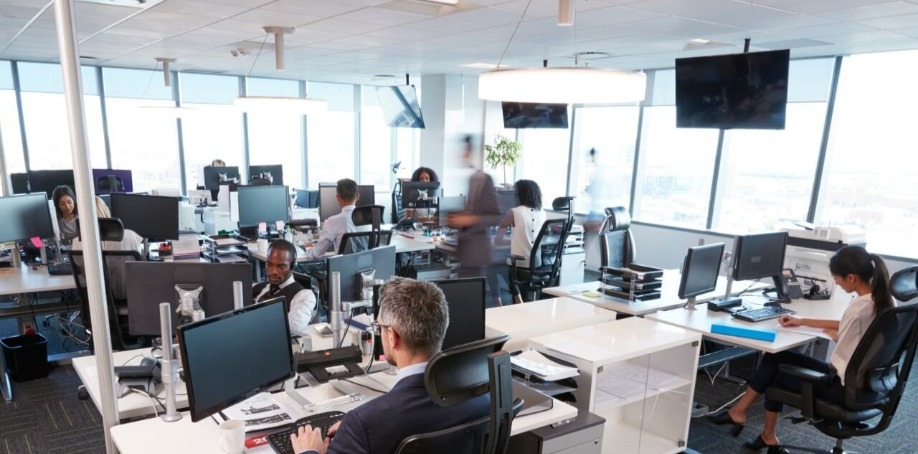
The modern, connected office relies on crisp audio and carefully synchronized video. Presentations, conference calls and research projects simply won't work without the proper technology backbone. Traditionally, all of that connectivity came with acres of wires, tons of expensive switches and ongoing maintenance hassles.
Enter audio-visual over IP (AVoIP).
Integrators have warmed to the technology, says Tom LeBlanc, director of industry outreach and media channels at National Systems Contractors Association. He points to a survey by Commercial Integrator which suggests that “about 80 percent of integrators are more-or-less ready to embrace AV-over-IP as a distribution solution for their customers.”
However, concerns about wiring, installation costs and construction timelines could keep building owners from adopting the solutions they need. Knowing more about what these systems do and how they work could ease worries and lead to more installations.
How Does Information Move?
Traditional AV systems rely on circuit-switched networks. Early telephone switchboards use this same system, writes S. Ann Earon, Ph.D., in a white paper for automation systems manufacturer Crestron. AVoIP systems break data into packets via an encoder, and a decoder reassembles the data. Each source device requires an encoder, and each destination device requires a decoder.
"It brings flexibility to new heights, since we can connect as many encoders and decoders as the network design requires with the capability to scale on an as-needed-basis and at lower costs along with easy expansions to ever-larger matrix configurations," explains Alan Williams, director of layer II systems at Premiere Communications.
Encoders and decoders must be connected, but AVoIP systems have simplified needs, when compared to their aging counterparts.
One IP cable can replace multiple point-to-point connections, says Bob Sobota at Advanced Network Management. Since AVoIP switches are bidirectional, any port could be an input or an output. "This dramatically reduces the underlying infrastructure (and cabling) required to install and scale your AV system," he notes. Cabling like this can cut installation costs, as building owners won't need to invest in multiple different types of wire, depending on the functionality of the system.
"Using common structured cabling vs. specialized audio, video, and control cables can provide a significant savings in material and labor. Less conduit and expensive dedicated AV cabling are required, and more standard RJ-45 connectors are used compared to expensive AV specific connectors," according to the team at Vantage Technology Consulting Group.

Will You Need New Cabling?
New construction opens a world of possibilities, as engineers and installers can develop and implement almost any system a business owner requires. Remodel projects are trickier, with the thought of adding acres of wire enough to make anyone quail. Pulling out the old system takes time, and punching through walls to access installation space adds to the cost of upgrading.
Still, AVoIP systems do require specific types of cabling, and those demands rise with distance. "IP-based AV can be transmitted over copper (Category) cable and over fiber optic quite conveniently. The Category (CAT-5, CAT-6, etc.) cable has a maximum of 100 meters," says the team at Matrox, a manufacturer specialized graphics solutions for professional markets.
At longer distances, installers can use switches and repeaters to increase the range without adding more cables. To make the right decision, integrators will need to talk with building managers about how the system will work both now and in the future. With upgrades, integrators will need to understand what sorts of cables are already inside the building.
Some building managers know exactly what cables are and are not within their buildings. Others don't. Even buildings that are 10 years old might have bits of technology that could be used in the remodel.
"Over the past decade, AV systems for applications like video displays, video conferencing and digital signage have shifted from connecting via traditional RCA coaxial, component cables and baluns to low-voltage network cabling such as balanced twisted-pair copper and optical fiber cables," according to Cabling Installation.
Investigation during the design phase could help contractors determine the best path forward. And there might be nice surprises along the way.
The team at manufacturing solutions provider AEM writes that some AVoIP projects come with a reduction in hardware and cabling. That can lead to lower cooling requirements and electrical bills. Any space gained could be used for new technologies that would benefit future tenants.
Technical Support Considerations
AVoIP systems are made to grow. It's very possible to add or remove devices within minutes, but for some companies, that isn't ideal.
"You can have, in theory, infinite control over every component. Anyone with access to the network can facilitate a meeting, establish a face-to-face conference, or record vital brainstorming. No more waiting for the IT folks to respond to pleas for help," writes Jon Bullard, engineer at Unified Technology Systems.
For companies dealing with IT staffing issues, this adaptability could be ideal. When one team member is out for the day and another isn't available, work won't grind to a halt.
Similarly, some IT teams appreciate the standalone nature of AVoIP systems. Tom Vestal, GIS specialist with Nez Perce County in Idaho, manages an office that recently went through an upgrade, and has expanded. “Since the install, we were able to easily integrate additional encoders and decoders without a problem,” he tells AV Network.
Administrators might appreciate doing that work without the help of a contractor or AVoIP specialist. When a change is required, they can do the work alone. But some companies have tight restrictions about network access, and others have concerns about security. The integrator should develop a deep understanding of those issues to ensure a successful project launch.
"As with most projects—but even more critically with AV-over-IP solutions—the client, technology manager, integrator, and programmer must all be on the same page regarding roles and responsibilities of getting devices configured and tested on the network," writes Steve Greenblatt, president of control system solutions provider Control Concepts.

Benefits of AVoIP in an Office
Why should a building owner invest in an AVoIP system? Can the installations really live up to the hype? Walking through a few examples can make the benefits clear.
White and Case
This law firm holds multiple meetings every day, and it isn't unusual for clients or other outsiders to bring their own presentation devices. In the past, these visitors didn't always have the proper adapters, so couldn't connect and share information, writes Jonathan Blackwood, editorial director at Commercial Integrator. With a new AVoIP system, they can walk in and collaborate within minutes.
The Boston Globe
Reporters and editors need to watch news as it unfolds. When a new headquarters for The Boston Globe was required, building owners knew every inch of the large newsroom as well as the 20 conference rooms and offices had to be saturated with technology to meet employee needs.
"Upon completion, the system featured more than 100 end points of IP distributed video and 20 conference rooms and executive offices equipped with in-room, wireless collaboration. News personnel can easily select the source they need and quickly put it up on the desired display, switch sources, tile up to four channels or video sources on the video wall, or scale it to provide a larger video screen for everyone to watch," writes the staff at Sound and Video Contractor.
PTC Headquarters
This company wanted a completely open floor plan with no assigned seating. Workers would come in, find a spot that seemed best, and start their work. Collaboration is key, and designers were required to create shared spaces connected via AVoIP.
"There are huddle rooms of different sizes and conference rooms with different purposes, any of which may require both PTC employees and clients to walk in and expect to be able to present and collaborate easily," writes LeBlanc.
That functionality simply wouldn't be possible with older systems. The wiring requirements alone would have made the cost prohibitive.
Bank Iowa Headquarters
This office space in Des Moines, Iowa, includes training rooms, meeting spaces, and administrative offices. Huddle spaces dot the corporate headquarters, and a sound-masking system covers the whole facility.
Sound-masking systems are critical for modern, open floor plans. They help muffle sounds from intimate conversations, business meetings and chirping devices, writes Zachary Comeau, associate editor at Emerald Expositions.
While this system is powerful, it doesn't require the acres of cabling associated with older AV tools. Even so, the Bank Iowa team chose to put their technology front and center in the design. "The building is more or less designed around the IT rack and room, which is kind of a showpiece. It's glass-enclosed and situated right in the middle of the main area," explains Mike Holmberg operations manager at Iowa Audio Video, the company that designed and installed the AV systems.
Images by: rawpixel/©123RF.com, stockbroker/©123RF.com, evgeniyshkolenko/©123RF.com


